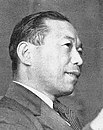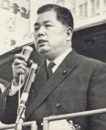House of Councillors elections were held in Japan on 4 July 1965,[1] electing half the seats in the House. The Liberal Democratic Party won the most seats.
1965 Japanese House of Councillors election|
|
|
|
|
First party
|
Second party
|
Third party
|
|
|

|

|

|
| Leader
|
Eisaku Satō
|
Kōzō Sasaki
|
Takehisa Tsuji
|
| Party
|
LDP
|
Socialist
|
Kōmeitō
|
| Seats after
|
140
|
73
|
20
|
| Seat change
|
 2 2
|
 6 6
|
 5 5
|
| Popular vote
|
17,583,490
|
8,729,655
|
5,097,682
|
| Percentage
|
47.2%
|
23.4%
|
13.7%
|
| Swing
|
 0.8% 0.8%
|
 0.8% 0.8%
|
 2.2% 2.2%
|
|
|
|
Fourth party
|
Fifth party
|
|
|

|

|
| Leader
|
Suehiro Nishio
|
Kenji Miyamoto
|
| Party
|
Democratic Socialist
|
JCP
|
| Seats after
|
7
|
4
|
| Seat change
|
 4 4
|

|
| Popular vote
|
2,214,375
|
1,652,364
|
| Percentage
|
5.9%
|
4.4%
|
| Swing
|
 0.6% 0.6%
|
 1.3% 1.3%
|
|
|
| |
|---|
| Party | National | Constituency | Seats |
|---|
| Votes | % | Seats | Votes | % | Seats | Not up | Won | Total
after | +/– |
|---|
| Liberal Democratic Party | 17,583,490 | 47.17 | 25 | 16,651,284 | 44.20 | 46 | 69 | 71 | 140 | –2 |
| Japan Socialist Party | 8,729,655 | 23.42 | 12 | 12,346,650 | 32.77 | 24 | 37 | 36 | 73 | +7 |
| Kōmeitō | 5,097,682 | 13.68 | 9 | 1,910,975 | 5.07 | 2 | 9 | 11 | 20 | +5 |
| Democratic Socialist Party | 2,214,375 | 5.94 | 2 | 2,303,860 | 6.12 | 1 | 4 | 3 | 7 | –4 |
| Japanese Communist Party | 1,652,364 | 4.43 | 2 | 2,608,771 | 6.92 | 1 | 1 | 3 | 4 | 0 |
| Other parties | 298,401 | 0.80 | 0 | 185,991 | 0.49 | 0 | 0 | 0 | 0 | 0 |
| Independents | 1,700,849 | 4.56 | 2 | 1,664,639 | 4.42 | 1 | 4 | 3 | 7 | +2 |
| Total | 37,276,816 | 100.00 | 52 | 37,672,170 | 100.00 | 75 | 124 | 127 | 251 | +1 |
|
| Valid votes | 37,276,816 | 93.42 | | 37,672,170 | 94.41 | | |
|---|
| Invalid/blank votes | 2,624,119 | 6.58 | | 2,232,535 | 5.59 | | |
|---|
| Total votes | 39,900,935 | 100.00 | | 39,904,705 | 100.00 | | |
|---|
| Registered voters/turnout | 59,544,407 | 67.01 | | 59,544,407 | 67.02 | | |
|---|
| Source: Ministry of Internal Affairs and Communications,[1][2] National Diet |




